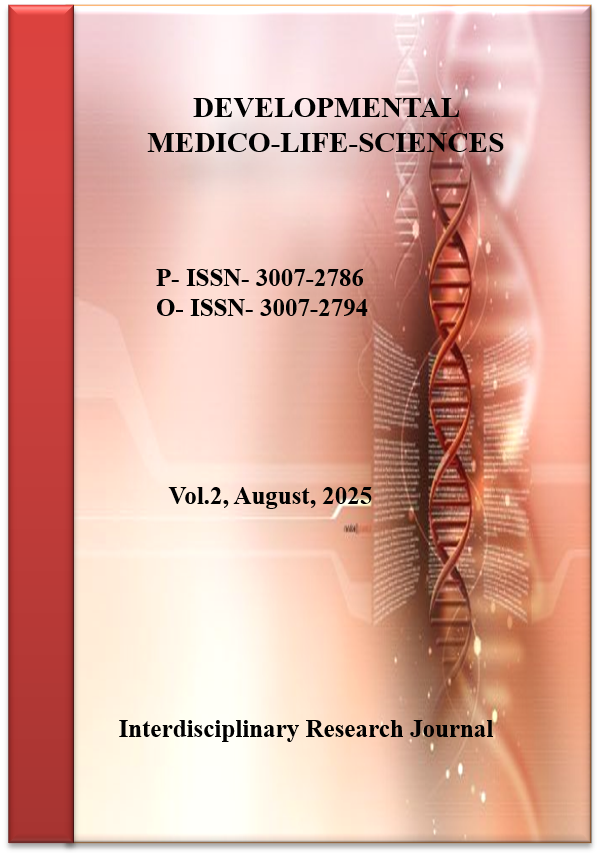Evaluation of Pulmonary Function Changes in Smokers versus Non-Smokers Using Spirometry
Treatment Analysis of Inflammatory Breast Disease
DOI:
https://doi.org/10.69750/dmls.02.08.0145Keywords:
Pulmonary function, spirometry, smokers, non-smokers, FEV1, FVCAbstract
Background: Cigarette smoking is a major preventable cause of morbidity and mortality worldwide, contributing significantly to chronic respiratory diseases. Pulmonary function testing using spirometry provides an objective means of assessing smoking-related airway impairment and detecting early subclinical changes.
Objective: This study aimed to evaluate pulmonary function changes among smokers compared to non-smokers using spirometry in a tertiary care setting in Punjab, Pakistan.
Methods: A Cross-sectional comparison study was conducted at two tertiary care facilities between March 2024 and March 2025. Using purposive sampling, 90 individuals between the ages of 20 and 60 were enrolled, 45 of them were smokers and the remaining 45 were non-smokers. Using a systematic questionnaire, demographic and clinical data, including smoking history, were collected. The American Thoracic Society (ATS) recommendations were followed while doing the spirometry, and the findings were assessed for peak expiratory flow rate (PEFR), forced expiratory volume in one second (FEV1), forced vital capacity (FVC), and FEV1/FVC ratio. The Statistical Package for Social Sciences (SPSS) software version 26 was used to analyze the data. Pearson's correlation test was used to determine the relationship between smoking exposure and spirometric indices, and independent t tests were used for group comparisons.
Results: Smokers demonstrated significantly reduced mean FEV1 (2.29 ± 0.61 L vs. 3.01 ± 0.55 L, p < 0.001), lower FEV1/FVC ratios (68.5% ± 7.2 vs. 81.1% ± 6.5, p < 0.001), and decreased PEFR (314.6 ± 72.8 L/min vs. 386.2 ± 68.9 L/min, p < 0.001) compared to non-smokers. Obstructive patterns were observed in 42.2% of smokers versus 8.9% of non-smokers. Pack-year analysis showed a significant inverse correlation with both FEV1 (r = –0.41, p = 0.004) and FEV1/FVC ratio (r = –0.38, p = 0.006).
Conclusion: Smoking is strongly associated with impaired pulmonary function, particularly obstructive airway changes. Spirometry is a valuable tool for early detection, highlighting the need for routine screening and targeted smoking cessation interventions to prevent progressive lung disease.
Downloads
References
Oelsner EC, Balte PP, Bhatt SP, et al. Lung function decline in former smokers and low-intensity current smokers: a secondary data analysis of the NHLBI Pooled Cohorts Study. Lancet Respir Med. 2020;8(1):34-44. doi:10.1016/S2213-2600(19)30276-0
McKleroy W, Shing T, Anderson WH, et al. Longitudinal follow-up of participants with tobacco exposure and preserved spirometry. JAMA. 2023;330(5):442-453. doi:10.1001/jama.2023.11676
Han MK, Ye W, Wang D, et al; RETHINC Study Group. Bronchodilators in tobacco-exposed persons with symptoms and preserved lung function. N Engl J Med. 2022;387(13):1173-1184. doi:10.1056/NEJMoa2204752
Stanojevic S, Graham BL, Cooper BG, et al. ERS/ATS technical standard on interpretive strategies for routine lung function tests. Eur Respir J. 2022;60(1):2101499. doi:10.1183/13993003.01499-2021
Smith BM, Kirby M, Hoffman EA, et al. Association of dysanapsis with chronic obstructive pulmonary disease among older adults. JAMA. 2020;323(22):2268-2280. doi:10.1001/jama.2020.6918
Wan ES, Balte P, Schwartz JE, et al. Association between preserved ratio impaired spirometry and clinical outcomes in US adults. JAMA. 2021;326(24):2487-2498. doi:10.1001/jama.2021.20766
Tian T, Jiang X, Qin R, et al. Effect of smoking on lung function decline in Chinese males: cross-sectional and longitudinal analyses. Front Med (Lausanne). 2023;10:843162. doi:10.3389/fmed.2022.843162
Fortis S, Comellas AP, Jacobs DR Jr, et al. Respiratory exacerbations in people with cigarette smoking but normal spirometry and subsequent lung function decline. Am J Respir Crit Care Med. 2025;211(6):e1-e12. doi:10.1164/rccm.202401-0023OC
Rodríguez-Álvarez MM, Sobrino-Leal A, Rodrigo-Matos A, et al. Spirometry-guided counseling and smoking cessation in primary care: randomized trial. Int J Environ Res Public Health. 2022;19(21):14557. doi:10.3390/ijerph192114557
Darabseh MZ, Al-Khatib S, Khassawneh B, et al. Impact of vaping and smoking on maximum respiratory pressures and spirometry. Int J Adolesc Med Health. 2021;33(6):461-468. doi:10.1515/ijamh-2021-0056
Balte PP, Chaves PHM, Couper DJ, et al. Nonobstructive chronic bronchitis and respiratory health outcomes in adults. JAMA Intern Med. 2020;180(5):676-686. doi:10.1001/jamainternmed.2020.0104
Çolak Y, Afzal S, Nordestgaard BG, Lange P. Characteristics and prognosis of never-smokers and smokers with airflow limitation in the general population. Respir Med. 2021;182:106402. doi:10.1016/j.rmed.2021.106402
Çolak Y, Afzal S, Nordestgaard BG, Lange P. Prognosis of symptomatic smokers with preserved spirometry. Eur Respir J. 2020;55(1):1901311. doi:10.1183/13993003.01311-2019
Çolak Y, Afzal S, Nordestgaard BG, Lange P. Association of smoking intensity with FEV₁ decline and COPD risk in the general population. Thorax. 2022;77(11):1052-1060. doi:10.1136/thoraxjnl-2021-218174
Çolak Y, Afzal S, Nordestgaard BG, Lange P. Smoking cessation, weight change, and lung function decline. JAMA Netw Open. 2020;3(11):e2027344. doi:10.1001/jamanetworkopen.2020.27344
Wang Z, Yang L, Qin L, et al. Low FEV₁ in young adults and subsequent morbidity and mortality: a population-based cohort. Respir Res. 2024;25(1):103. doi:10.1186/s12931-024-02777-6
Mehta P, Hall GL, Stanojevic S, et al. Global Lung Function Initiative (GLI) reference values update for spirometry in adolescents and adults: multi-ethnic data harmonization. Eur Respir J. 2022;60(5):2201693. doi:10.1183/13993003.01693-2022
Washio Y, Sato S, Tanaka J, et al. Small airway dysfunction assessed by spirometry indices and smoking exposure in adults without COPD. Respir Investig. 2021;59(6):760-768. doi:10.1016/j.resinv.2021.08.006
Mahler DA, Criner GJ, Dransfield MT, et al. Peak inspiratory flow rate, smoking history, and airflow limitation: implications for inhaler therapy. Chest. 2021;160(5):1735-1746. doi:10.1016/j.chest.2021.05.063
Çolak Y, Afzal S, Nordestgaard BG, Lange P. Preserved ratio impaired spirometry, respiratory symptoms, and all-cause mortality. Eur Respir J. 2021;57(1):2000045. doi:10.1183/13993003.00045-2020
Porteous MK, Lee HJ, Han MK, et al. Quantitative CT metrics and symptoms in smokers with preserved spirometry. Chest. 2020;158(2):792-803. doi:10.1016/j.chest.2020.01.058
Doiron D, de Hoogh K, Probst-Hensch N, et al. Air pollution, smoking and lung function in cohorts across Europe: the ALEC study. Int J Epidemiol. 2020;49(1):149-161. doi:10.1093/ije/dyz063






















